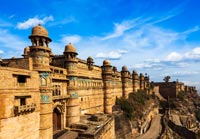
Gwalior Fort is a majestic looking hill fort located near Gwalior in Madhya Pradesh. This impenetrable fort features a defensive structure and two grand main palaces. Beautifying the skyline of Gwalior, its architectural style impresses all and underlines excellent craftsmanship of the artists of the bygone era.
Nestling with concrete walls of sandstone, the Gwalior Fort is home to three ancient temples, six royal palaces and several water tanks. All palaces and temples here are proud caretakers of the diverse architectural art of the past which still makes many jaws drop. ?Man Mandir Palace remains the most popular and most beautiful of all palaces here adorned with wonderfully elaborate structures with blue ceramic tiles which add beautiful colours to this palace. The Teli-ka-Mandir here flaunts the 9th-century Dravidian style of architecture and stands over a height of 100 feet. Visitors get awe-struck by its beauty displayed in the form of North Indian decorative motifs and elegantly sculpted exterior. Also, explore the Saas-Bahu temples located on the eastern side. With their11th-century architecture, these temples add to the beauty of the fort.
The fort hosts a very beautiful sound and light show during evening hours. ?The show underlines the spectacular history of the fort and the romantic tales of Raja Man Singh and his queen Mrignayani. ?Visit amphitheatre at the Man Mandir to partake in this show.
Siddhachal Jain Temple Caves
Built in 7th to 15th century, these eleven Jain temples are dedicated to the Jain Tirthankaras. The most fascinating attraction here is the idol of Rishabhanatha or Adinatha, the 1st Tirthankara, which rises to a height of 58 feet 4 inches.
Urvahi
Gwalior fort has been divided into Gwalior fort - Urvahi, North West, North East, South West and the South East areas. The Urvashi exhibits 24 idols of Tirthankar in the padmasana posture, 40 in the kayotsarga posture and over 840 idols engvaed on the walls.
Gopachal
Gopachal Hill has around 1500 idols which have been made by cutting down hilly rocks. ?Most of these were constructed between 1341-1479 during the rule of King Dungar Singh and Keerti Singh of Tomar dynasty.
Teli ka mandir
This Hindu temple dates back to the 8th to 9th century. This remains the oldest section of the fort blending together south and north Indian architectural styles. The shrine here does not have pillared pavilions and is topped by a South Indian barrel-vaulted roof.
Man mandir palace
Raised by the King of Tomar Dynasty - Maharaja Man Singh, Man mandir palace flaunts a unique painted effect due to the use of multicoloured tiles which create a geometric pattern.
Museum
The Gujari Mahal of the fort was constructed by Raja Man Singh Tomar for his wife Mrignayani. The palace was later converted into an archaeological museum displaying some rare artefacts, including Hindu and Jain sculptures.
By Air: Gwalior Airport is well connected with Delhi and other cities of Madhya Pradesh.
By Rail: Gwalior junction is the main railway station for this city.
By Bus: Gwalior city is well connected with all parts of Central India & North India.